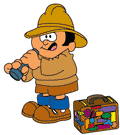
The Formation of the Galapagos Islands

Unit Topic: The Galapagos Islands
Grade Level: Middle School
Basic Concepts: Experimentation, Formation, Research
Content Areas: Science, Language Arts
Time: 1 1/2
Objectives
Activity 1
Phase 1: Students will watch the segment "Fires of Creation" from the video Galapagos Beyond Darwin. The segment is approximately 12 minutes long.
Materials: video, TV/VCR
Phase 2: The teacher
will then involve the class in an interactive discussion. Slides, photographs,
diagrams, videos, pictures from the Internet, and young adult literature can
be used to support the discussion. A suggested order of topics follows.
Materials: diagrams, The Magic School Bus Inside the Earth, other visuals
Phase 3: Students will then do a short experiment. They will divide into groups of three or four. Each group will make a volcano. Instructions for two different types of volcanoes follow. One makes a larger volcano, while the other makes a smaller scale volcano. [Note: The teacher should be aware that, if the experiment is done correctly, what students will actually see is a lava flow. You may wish to warn students that they should not expect a big reaction. Because there are no sounds effects or pyroclastics, the reaction may not seem that impressive.] Each student will also complete the lab report that follows.
Materials: instructions, lab report
Phase 4: The class will then return to the interactive discussion. The next topic to discuss is the different ways in which the Galapagos Islands formed. Inform students that not all of the islands formed in the same way. Also share with students that one can often "guess" the age of an island by the amount of vegetation present. The more an island is densely vegetated, the older it is.
Ask students to choose one of the islands. Give students time to do a quick search on the Internet to find information about their island. Specifically, they should look for:
1) How did their island form? What are its volcanic characteristics?
2) How would one describe the vegetation?
3) Would you predict that the island is rather old or fairly new? Students will include this information in their travel brochure about one of the islands (see the lesson "Travel Brochures").
Assessment: In phase 2 students will complete the lab report. The lab report will be assessed as to completion. If a student does not seem to grasp the concept of the experiment, he or she will be given a chance to redo it under the guidance of a peer who did understand. Phase 4 will be assessed as part of the travel brochure lesson.
Extensions:
1. Students may wish to build their volcano by shaping it with clay or other materials.
2. Students may wish to build a model of the Galapagos Islands.
Resources:
Cole, J. (1987). The Magic School Bus Inside the Earth. New York: Scholastic Inc. [0-590-40760-0]
Video: *Clark, D. & Giddings, A. (Producers and Directors). (1996). Galapagos Beyond Darwin [Film]. Available from Discovery Channel Video.
Diagram: *Bramwell, M. (1987). The Oceans. London: Franklin Watts. [0-531-10356-0]
Diagram: *Zeman, A. & Kelly, K. (1994). Everything You Need to Know About Science Homework. New York: Scholastic Reference. [0-590- 49357-4]
Lithograph: National Aeronautics and Space Administration. "Global Sea Surface Temperature." HqL-324.
Volcano 1: *Kenda, M. & Williams, P.S. (1992). Barrons science wizardry for kids. New York: Scholastic, Inc. [0-590-69236-3]
Volcano 2: Prentice Hall. (1994). Integrated science activity book. Englewood Cliffs, NJ: Author. [0-13-402199-1]
Other Suggested Resources (*designates "youth-friendly"):
Info about islands, issues affecting the Galapagos, what it's like to work at the Station, scientific reports, and conservation. Many (but not all) of the sites within the page are youth-friendly.
Mrs. Frizzle and her class take a trip to the ocean bottom, stopping on the way to explore the mysteries of the deep.
A web site sponsored by ecuadortours.com. Provides very general information for tourists about the islands and the National Park and Marine Reserve.
Web site run by ecuadortours.com. This section provides brief information about some of the main islands in the Galapagos.
Includes pictures, links, specific information about the islands, issues, references, climate, and National Park Rules.
A tour company's home page. Begins with legend of the Galapagos. Leads into links about specific tours or general information about the islands.
Traveler's log of a 7-day journey through the Galapagos. Includes pictures and a map of the Islands.
Deals with the birth, evolution, and death of oceanic islands. Concentrates on processes of plate tectonics. Fairly technical language. Many full-color illustrations and diagrams.